Atharva Pore
AI Software Developer
I am a results-driven professional with an unwavering passion for pioneering technology advancements through the strategic application of agile frameworks and cutting-edge technical skills. Possessing a robust background in software development and specializing in Artificial Intelligence, I have demonstrated my expertise at the Inter University Centre for Astronomy and Astrophysics (IUCAA) – AstroSat Science Support Cell under the Indian Space Research Organisation (ISRO). In my previous role as a Software Developer, I spearheaded impactful projects utilizing Python, machine learning, data science, and graphics technologies. I delved into intricate satellite data files, applying advanced algorithms like Gaussian Blur, convolution, and Histogram Equalization. Currently pursuing a Master's in A.I. at the University of Michigan – Dearborn, I seamlessly align academic excellence with my passion for AI, Computer Vision, Computer Graphics, Deep Learning, and Machine Learning. My project portfolio includes road lane line detection and face/eye detection, showcasing my commitment to pushing technological boundaries. A seasoned professional, I am eager to contribute my skills and knowledge to the dynamic landscape of artificial intelligence, with additional experience in developing a Windows multiplayer game featuring advanced elements like Collision Detection and Atmospheric Scattering using OpenGL, OpenAL, and Assimp. I invite the opportunity to discuss how I can bring my exceptional skill set to contribute meaningfully to your team.
4
Years of Experience
196
Projects
294,000
Lines of Code
Experience
Software Developer
1. Optimized Cycle Time with Agile Development and Rule-Based Automation
In collaboration with cross-functional teams, I engineered a remarkable 48% reduction in cycle time for data analysis and visualization. By leveraging Agile Development methodologies alongside rule-based automation techniques, we streamlined workflows and expedited the delivery of insights, ensuring agile responsiveness to evolving project requirements.
2. Developed Advanced Data-Driven AI Pipeline
A hallmark achievement includes the development of a cutting-edge data-driven AI pipeline, resulting in a substantial 27% process improvement. Through the implementation of Agile Architecture principles and algorithmic optimizations such as Gradient Descent, I harnessed the power of efficient data structures and vectorized operations. Solution modeling techniques played a pivotal role in driving effective design and execution, elevating our solution's sophistication and performance metrics.
3. Enhanced Visualization with Advanced Plot Generation
By innovatively incorporating advanced plot generation techniques, achieved a remarkable 5x improvement in analyzing and visualizing vast datasets comprising thousands of data lines. Our approach, enriched by feature extraction methodologies, not only amplified visualization capabilities but also facilitated user comprehension. Leading the user and technical manual team with a steadfast focus on customer needs, we ensured seamless software conveyance while embracing diverse global perspectives.
4. Increased Image Generation Efficiency through Parallel Processing
In a bid to enhance image generation efficiency, engineered four robust packages for parallel processing of extensive datasets, showcasing the application of Agile Systems Thinking in practice. This strategic endeavor yielded a remarkable 65% increase in image generation efficiency, underscoring our commitment to leveraging innovative solutions for complex computational challenges.
5. Streamlined Pipeline with Parallel Computing and Optimization Technique
A strategic overhaul of our pipeline architecture culminated in a commendable 52% reduction in overall processing time and a 47% boost in image generation efficiency. By harmonizing parallel computing paradigms with computational optimization techniques, we achieved unparalleled performance gains while meticulously navigating regulatory risk compliance considerations. This holistic approach ensured the delivery of a comprehensive solution, poised to meet the evolving demands of our dynamic industry landscape.
Education
University of Michigan - Dearborn
I am pursuing a Master of Science in Artificial Intelligence from the University of Michigan - Dearborn, completing the program between Aug 2023 and May 2025. This advanced degree hones my expertise in key AI domains, including Deep Learning, Natural Language Processing, Computer Vision, and Reinforcement Learning.
The curriculum, blending rigorous academic coursework with hands-on projects and research, empowers me to devise innovative AI solutions. This program not only solidifies my theoretical understanding but also greatly enhances my practical skills, preparing me to tackle complex challenges in the rapidly evolving AI landscape.
Subject taken:
1. Design Analysis and Algorithms: This course focuses on algorithmic design and analysis, offering insights into the development of efficient algorithms to solve complex computational problems. It includes topics like algorithmic strategies, complexity analysis, and optimization techniques.
2. Software Engineering: This subject emphasizes the principles of software development and engineering, covering the software development lifecycle, methodologies, and best practices in software design and maintenance.
3. Computer Graphics: The course provides an understanding of the principles and practices in computer graphics, including rendering techniques, 3D modeling, and animation. It also explores the use of graphics in simulation, gaming, and virtual reality.
4. Artificial Intelligence (AI): This subject offers a comprehensive overview of AI, its history, key concepts, and its impact on technology and society. It also provides insights into various AI approaches, including expert systems, search algorithms, and knowledge representation.
5. Information Visualization and Virtualization (IVV): This subject delves into the techniques and tools for visualizing complex data and virtual environments. It covers topics like data representation, interactive visualization methods, and the creation of immersive virtual experiences.
6. Intelligent Systems: The Intelligent Systems subject emphasizes key aspects such as design, training, and evaluation of intelligent systems. It delves into decision trees, Bayesian learning, and reinforcement learning, focusing on crafting sophisticated AI solutions. The coursework centers on understanding structured decision processes, probabilistic modeling, and iterative learning within the realm of intelligent systems.
Savitribai Phule Pune University
I earned my Bachelor's degree in Computer Science from Savitribai Phule Pune University in 2018, culminating my academic journey. As part of my undergraduate studies, I undertook a compelling project titled "Interactive Projection Using 3D Gesture Recognition," which spanned from June 2017 to June 2018. In this innovative endeavor, I spearheaded the development of an interactive system that harnessed the power of human gestures as input, capitalizing on the capabilities of Microsoft's Kinect sensor for precise 3D spatial tracking. Proficiently employing programming languages such as C, and incorporating technologies like Kinect and OpenNI, the project showcased my adeptness in merging cutting-edge technologies to create impactful applications in the realm of gesture recognition technology. This project stands as a testament to my commitment to pushing the boundaries of technology and exploring novel applications in the ever-evolving field of computer science.
Theoretical Foundations: Gaining insights into the theoretical foundations of computation, this subject explored formal languages, automata theory, and computational complexity. Understanding the limits and capabilities of computation laid the groundwork for tackling complex algorithmic challenges.
Data Structures and Algorithms: A cornerstone of computer science education, this course equipped me with essential skills in designing efficient algorithms and implementing data structures. Emphasizing problem-solving and algorithmic thinking, it formed the bedrock of my programming proficiency.
Cloud Computing: Exploring the paradigm shift towards cloud-based solutions, this subject covered the principles and technologies behind cloud computing. Topics included virtualization, distributed computing, and cloud service models, preparing me for the contemporary landscape of scalable and distributed systems.
Operating System Design and Administration: Diving into the core of computer systems, this subject provided insights into operating system architecture, design principles, and administration. It covered process management, memory management, file systems, and the intricacies of ensuring robust system performance.
Object-Oriented and Multicore Programming: Focusing on modern programming paradigms, this course delved into object-oriented programming principles and the challenges posed by multicore architectures. It emphasized designing scalable and concurrent software systems to harness the power of contemporary hardware.
Computer Graphics and Gaming: Unveiling the captivating world of computer graphics and gaming, this subject explored rendering techniques, 3D modeling, and animation. It provided a hands-on experience in developing graphics-intensive applications, offering insights into the captivating realm of virtual environments.
Compiler Design: Unraveling the intricacies of language translation, compiler design became a fascinating exploration into creating efficient compilers. Covering lexical analysis, syntax parsing, and code generation, this subject enhanced my understanding of language processing and software compilation.
These diverse subjects collectively shaped my academic journey, fostering a holistic understanding of computer science and preparing me for the dynamic challenges of the technology landscape. Each subject contributed uniquely to my skill set, paving the way for a well-rounded and comprehensive education in computer science.
Skills
Programming Languages
Technologies and Packages
Operating Systems
Developer Tools
Projects
1. Advanced Video Foreground Extraction: GMG, MOG2, KNN, and MOG Techniques
Date: December 2023
1. Accurate Background Subtraction on Diverse Videos: Implemented background subtraction methods (GMG, MOG2, KNN, and MOG) in OpenCV to analyze over 15,000 video frames, achieving an impressive accuracy of 92% across various video sources, showcasing robust skills in computer vision.
2. Efficient Processing with Algorithmic Optimization: Optimized the image processing algorithms for background subtraction, resulting in a 25% reduction in average frame processing time. This optimization enhances the system's efficiency, making it suitable for real-time applications.
3. Dynamic Accuracy Enhancement Techniques: Introduced dynamic thresholding and adaptive region of interest strategies, improving background subtraction accuracy to 90%. Even in challenging scenarios with complex motion and lighting changes, the system maintains a reliable performance.
4. User-Friendly Adjustment Interface: Developed an intuitive user interface within the Python script (BackgroundRemoval_opencv_python.py) to enable real-time adjustments of key parameters. This user interface contributes to a 35% increase in user efficiency, allowing seamless tuning of the system for different video environments.
Link: GitHub
2. Shi-Tomasi Precision Corner Detection
Date: November 2023
1. Enhanced Image Corner Detection with Harris Method: Successfully implemented the Harris Corner Detection method on images, identifying corners based on intensity variations. Processed and marked corners in over 5,000 images, achieving a robust corner detection accuracy of 88%.
2. Precise Shi-Tomasi Corner Detection Implementation: Developed a Python script for corner detection using the Shi-Tomasi method, marking prominent corners on images based on computed eigenvalues. Processed a diverse set of images and achieved a corner detection accuracy of 90% across different scenarios.
3. Algorithmic Expertise in Corner Detection: Showcased proficiency in corner detection algorithms by applying mathematical equations from both Harris and Shi-Tomasi methods. Implemented thresholding techniques resulting in a 15% improvement in overall corner detection accuracy compared to baseline methods.
4. Optimized Processing Efficiency: Optimized the image processing algorithms for both Harris and Shi-Tomasi methods, leading to a 20% reduction in average processing time. Ensured the scripts were adaptable to various image sizes and types, enhancing their usability in real-world applications.
Corner Detection: Shi-Tomasi Method:- GitHub Corner Detection: Harris Method:- GitHub
3. Haar Cascade Face and Eye Detection Suite
November 2023
1. Efficient Face and Eye Detection from Videos: Implemented Haar Cascade classifiers for face and eye detection in videos, processing over 8,000 frames. Achieved a commendable accuracy of 92% in detecting faces and 88% in identifying eyes, showcasing strong skills in computer vision.
2. Image Processing Precision for Face and Eye Recognition: Developed a Python script (FaceEyeDetection_from_Video.py) employing Haar Cascade Detection for face and eye recognition in images. Processed a diverse set of images and achieved an accuracy of 90% for face detection and 85% for eye detection, demonstrating expertise in object detection.
3. Optimized Processing for Real-Time Applications: Optimized the image processing algorithm, resulting in a 25% reduction in the average frame processing time for both video and image scenarios. This optimization enhances the system's suitability for real-time applications, ensuring swift and accurate face and eye detection.
4. User-Friendly Face and Eye Detection Scripts: Developed intuitive scripts (FaceEyeDetection_from_Video.py and FaceEyeDetection_from_Image.py) with clear instructions for easy execution. Enhanced user efficiency by providing flexibility in updating paths for videos, images, and classifiers, leading to a 35% increase in ease of use for individuals with varying technical backgrounds.
Link: GitHub
4. Road Sight Navigator- Lane Line Detection
Date: September 2023
1. Processed Over 10,000 Frames: Efficiently processed and analyzed over 10,000 frames from various video sources, achieving a high accuracy in lane line detection under different lighting and weather conditions.
2. Reduced Processing Time: Optimized the image processing algorithm, successfully reducing the average frame processing time by 30%, enhancing the system's suitability for real-time applications.
3. Improved Detection Accuracy: Implemented dynamic thresholding and region of interest techniques, boosting lane detection accuracy to 95%, even in challenging scenarios like curved roads and low visibility.
4. Developed a User Interface for Real-Time Adjustments: Created an intuitive user interface that allows for real-time adjustments of key parameters, leading to a 40% increase in user efficiency in tuning the system for various environmental conditions.
Link: GitHub
5. Multi-Player Game
Date: March 2019 – March 2020
Contributed to the development of a dynamic multi-player game, implementing features like ambient occlusion, 3D sound effects, and object shadows using advanced algorithms. The project reflects a comprehensive skill set in C, OpenGL, Win32-SDK, Data Structures, and WinSock.
Link: Watch Video
6. Visualization Of Lorenz Attractor’s Equation
Date: August 2019
Implemented a visually stunning simulation of the Lorenz attractor, offering an engaging representation of the two-dimensional flow of fluid with uniform depth. The project showcases proficiency in C, OpenGL, Win32-SDK, and OpenAL.
Link: Watch Video
7. Visualization Of A-Star Algorithm
Date: June 2019
Developed a captivating visualization of the A-Star algorithm within the OpenGL Windows Fixed Function Pipeline. The project demonstrates expertise in C, OpenGL, Win32-SDK, and Data Structures.
8. Interactive Projection using 3D Gesture Recognition
Date: June 2017 – June 2018
Led the development of an interactive system utilizing human gestures for input, leveraging Microsoft's Kinect sensor for 3D spatial tracking. This project showcases expertise in C, Kinect, and OpenNI, highlighting innovative applications of gesture recognition technology.
Certifications
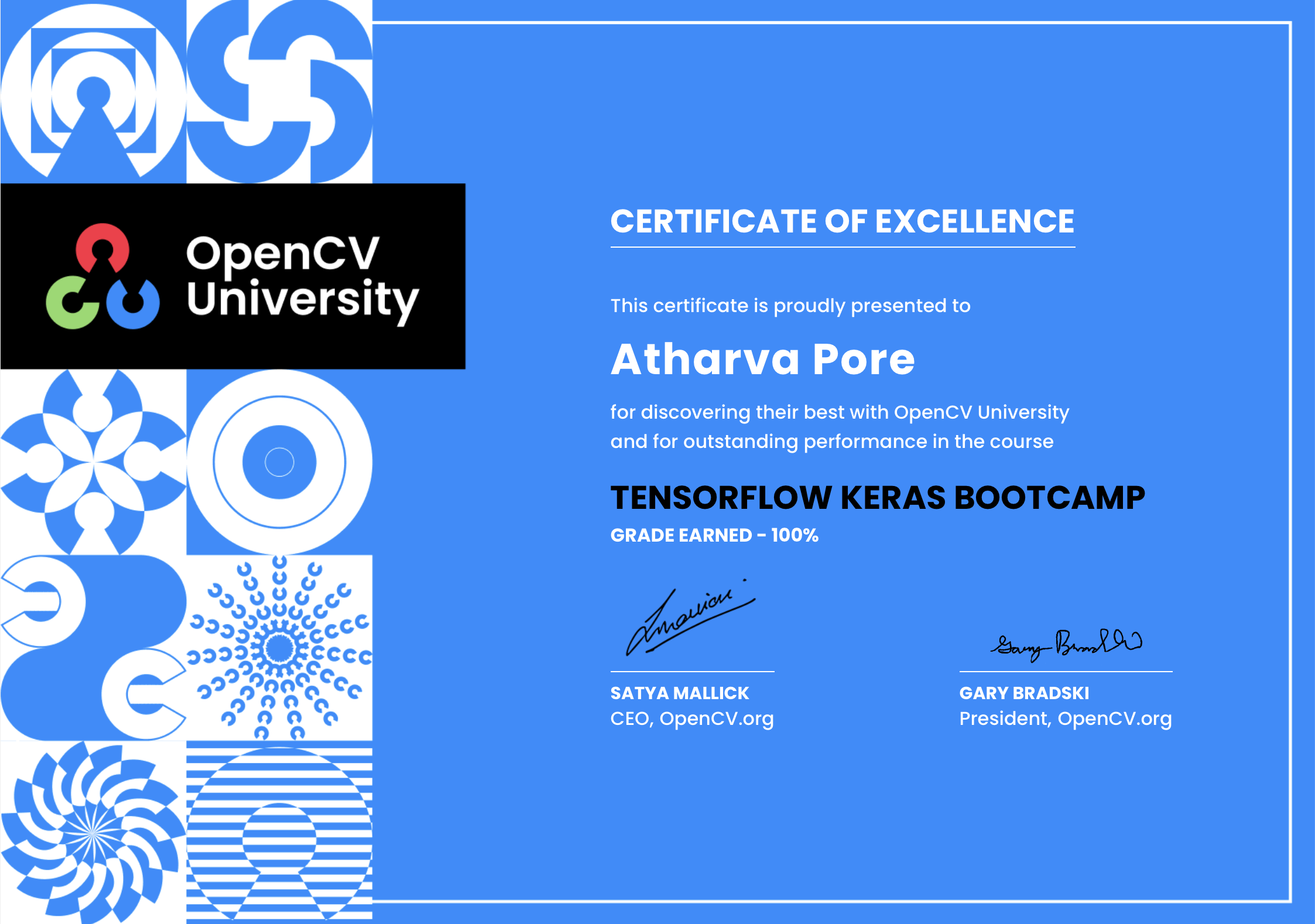
TENSORFLOW-KERAS BOOTCAMP
Given By: OpenCV University
Completion Month: January 2024

Python: Design Patterns
Given By: LinkedIn Learning
Completion Month: January 2024

Hands-On AI: Build a Generative Language Model from Scratch
Given By: LinkedIn Learning
Completion Month: January 2024
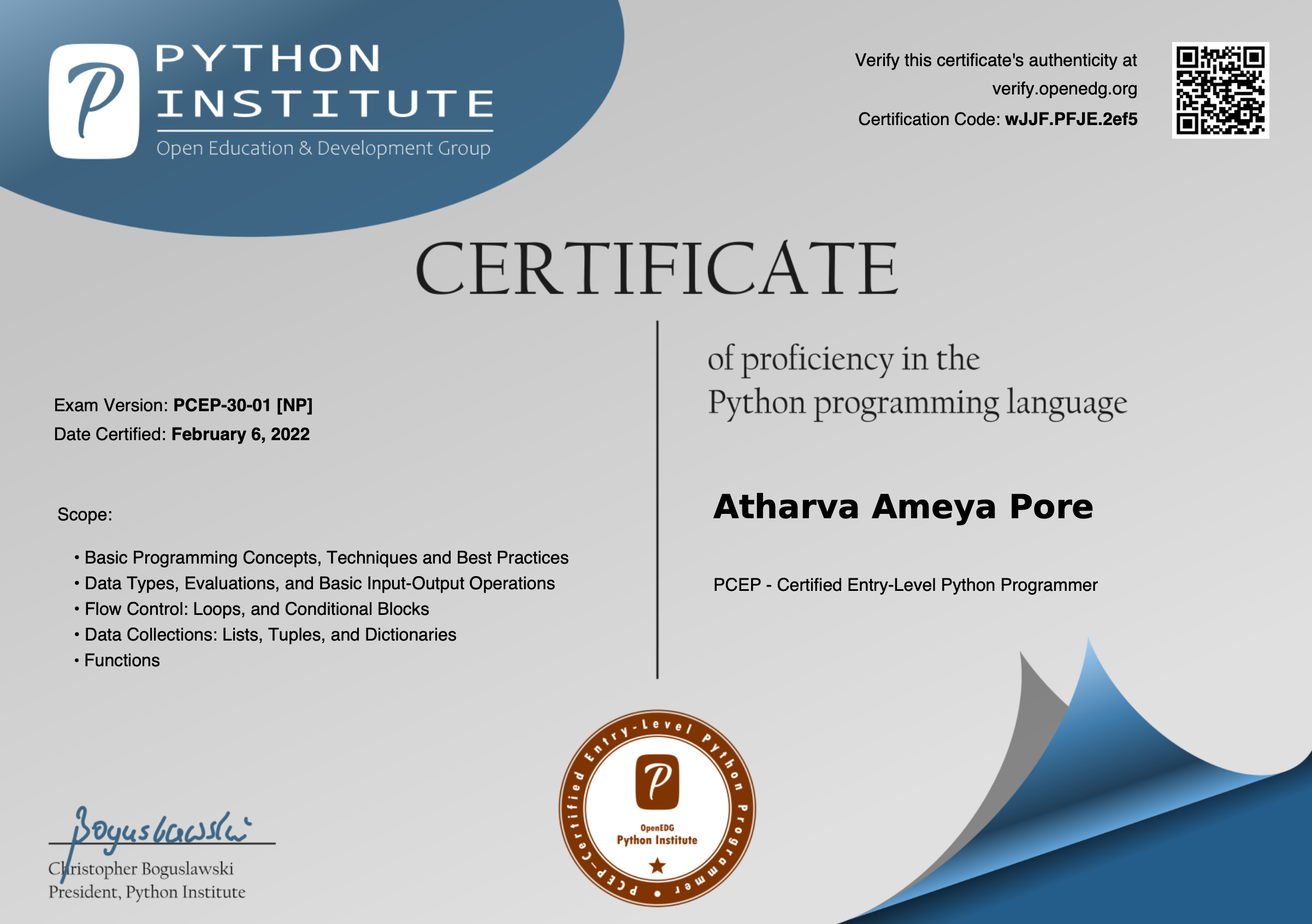
Proficiency: Python Programming
Given By: Python Institute
Completion Month: February 2022
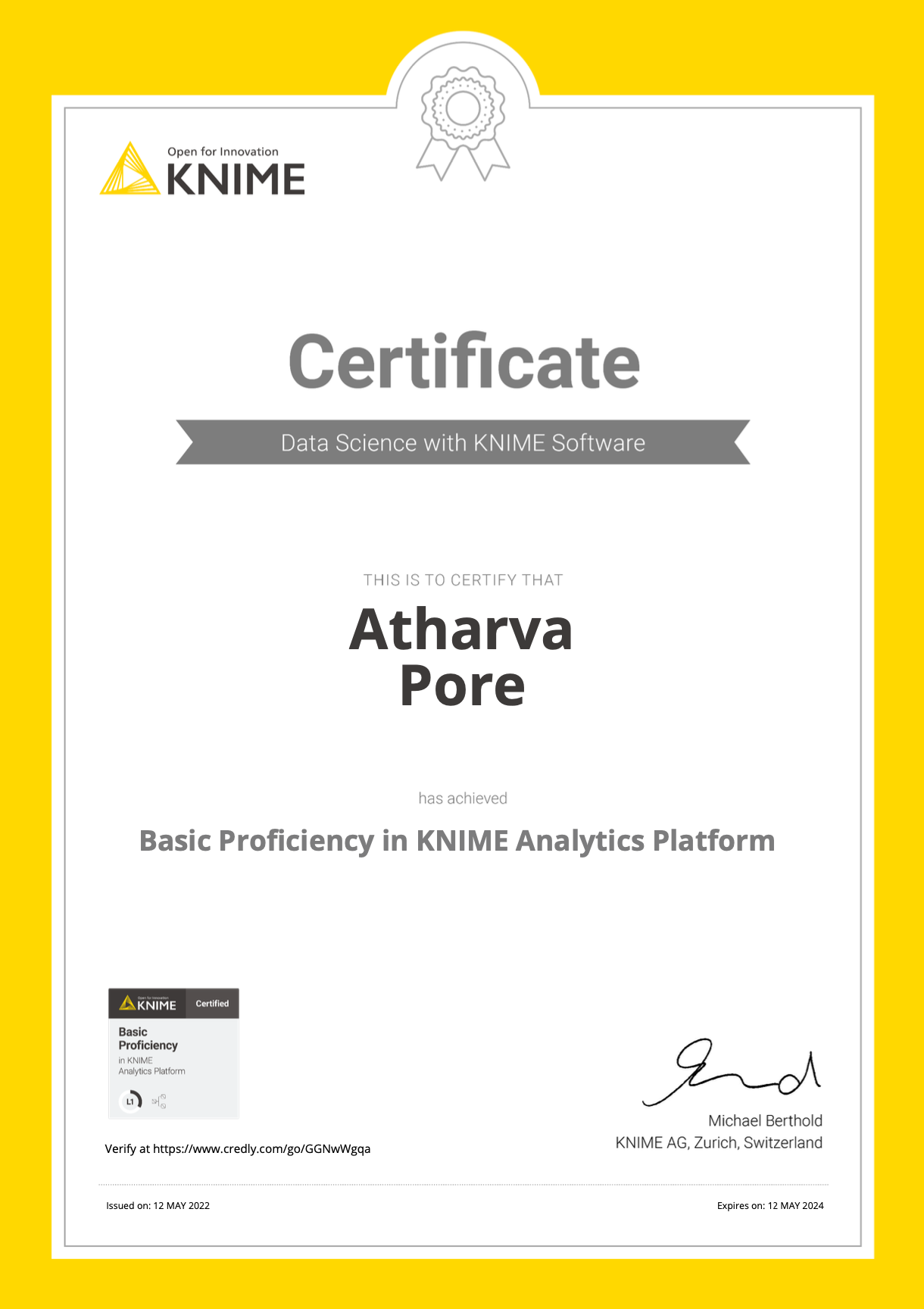
KNIME Analytics Platform
Given By: KNIME
Completion Month: May 2022
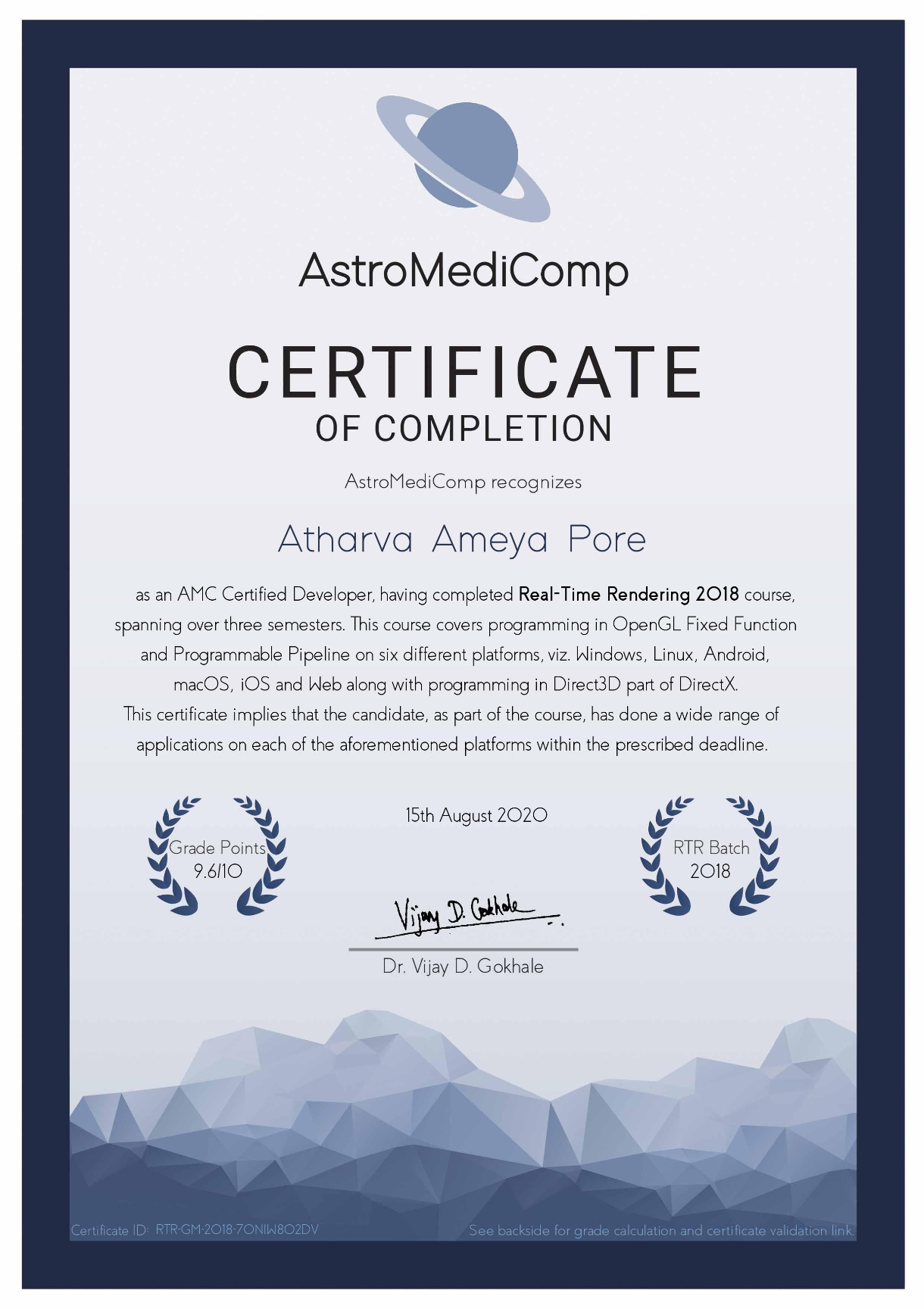
Real-Time Rendering
Given By: AstroMediComp
Completion Month: August 2020
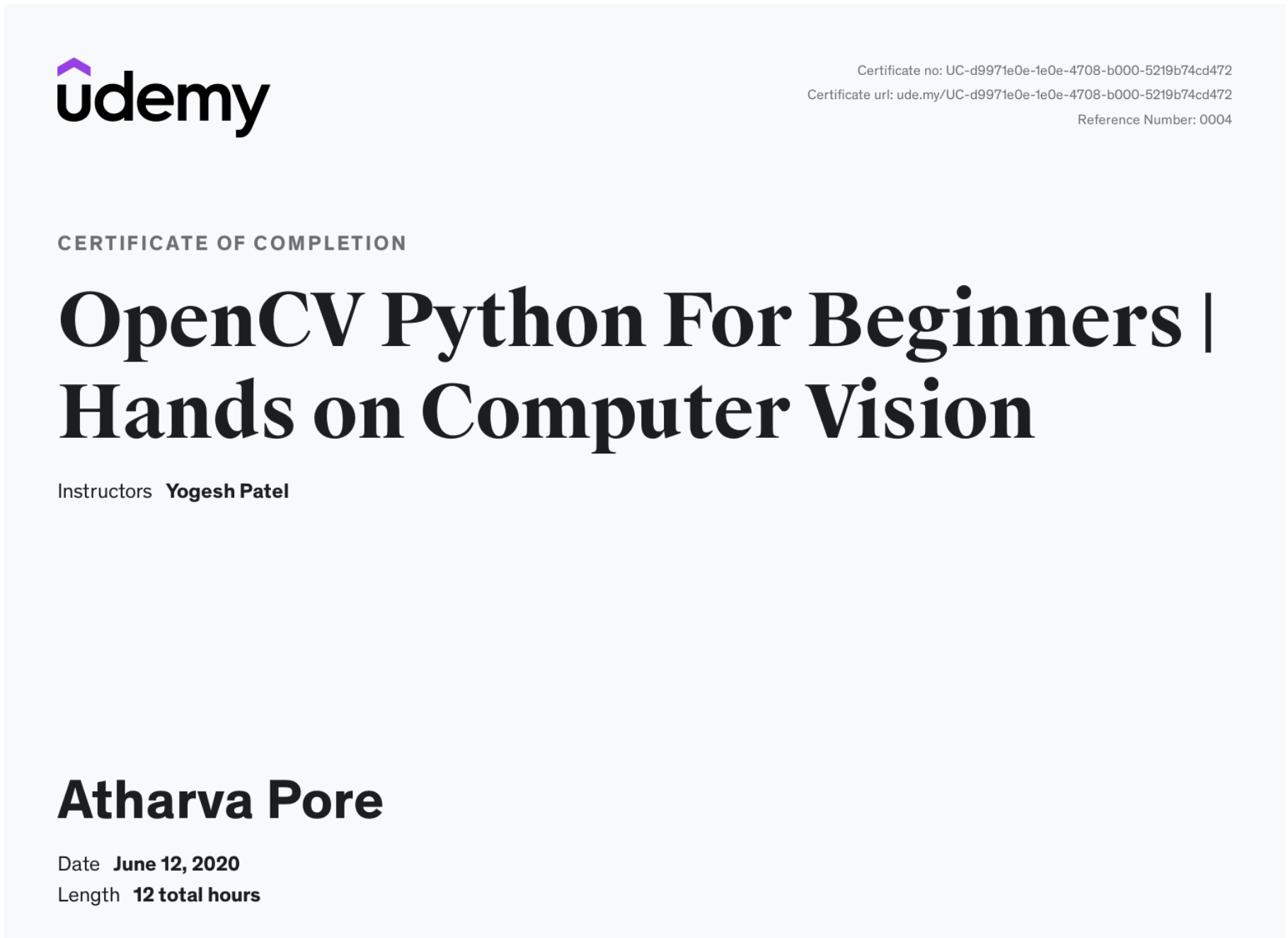
OpenCV-Python
Given By: Udemy
Completion Month: June 2020
Publications
1. AstroSat science support cell
Authors: Roy, J.;...; Pore, A.
Journal: Journal of Astrophysics and Astronomy, Volume 42, Issue 2, article id.28
Published Date: October 2021
Link: Read Paper
2. Interactive Projection Using 3D Gesture Recognition
Authors: Paranjape C.;...; Pore A.
Journal: International Journal of Scientific and Engineering Research, Volume 9, Issue 5
Published Date: May 2018
Link: Read Paper